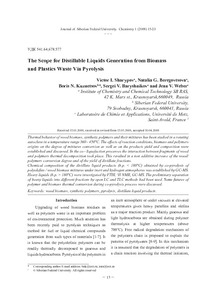The Scope for Distillable Liquids Generation from Biomass and Plastics Waste Via Pyrolysis
Скачать файл:
URI (для ссылок/цитирований):
https://elib.sfu-kras.ru/handle/2311/697Автор:
Sharypov, Victor I.
Beregovtsova, Natalia G.
Kuznetsov, Boris N.
Baryshnikov, Sergei V.
Weber, Jean V.
(Victor I. Sharypov, Natalia G. Beregovtsova, Sergei V. Baryshnikov: Institute of Chemistry and Chemical Technology SB RAS,42 K. Marx st., Krasnoyarsk,660049, Russia; Boris N. Kuznetsov: Siberian Federal University,79 Svobodny, e-mail: bnk@icct.ru, inm@icct.ru; Jean V. Weber: Laboratoire de Chimie et Applications, Université de Metz,Saint-Avold, France)
Дата:
2008-04Аннотация:
Thermal behavior of wood biomass, synthetic polymers and their mixtures has been studied in a rotating autoclave in a temperature range 360 - 450°C. The effects of reaction conditions, biomass and polymers origins on the degree of mixtures conversion as well as on the products yield and composition were established and discussed. In the co - liquefaction processes the interaction between fragments of wood and polymers thermal decomposition took place. This resulted in a non additive increase of the wood/polymers conversion degree and of the yield of distillate fractions.
Chemical composition of the distillate liquid products (b.p. < 180°C) obtained by co-pyrolysis of polyolefins / wood biomass mixtures under inert and hydrogen atmospheres was established by GC-MS. Heavy liquids (b.p. > 180°C) were investigated by FTIR, 1H NMR, GC-MS. The preliminary separation of heavy liquids into different fractions by open LC and TLC methods had been used. Some futures of polymer and biomass thermal conversion during co-pyrolysis process were discussed.

